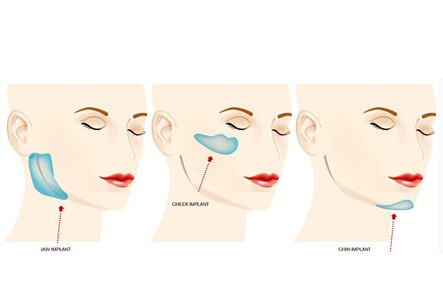Facial Implants
Introduction
Facial implants are created for augmentative, reconstructive or rejuvenative purposes which add or restore contour and proportion to the face. Implants are designed in a broad range of sizes and styles for the chin, jaw, nose and cheek.
Skin, soft tissues and underlying facial bones determine the facial appearance. It is very important to have visible contours, defined facial features and natural angles- that are in structural proportions- in order to create aesthetic balance in face and a more attractive appearance.
Patients with gum or dental problems will want to talk to their dentist.
Plastic surgery involving facial implants may benefit patients with small chin, weak jaw or lack of facial contour. Practically any facial area can be augmented with implants, the most common sites for facial implants are the cheekbones, chin and jaw. Facial implants define patient’s face by designing more sharp features and by increasing projections. Facial implants bring balance and better proportion to the structural appearance of patient’s face.
Iran leaps into world’s top 10 countries performing plastic surgery

Basically, facial implants are specially formed solid, biocompatible materials. The accurate type and size of implants required by a patient can be best judged by the plastic surgeon based on the assessment of objectives of the surgery and the desired features for facial correction.
1. Jaw implants help to increase the width of the lower third of the face. A weak jaw can be thought of as one that is not well-defined and distinct from the neck, or one that slopes rather than angles from the ear to the chin. In some cases, both the chin and jaw can contribute to facial imbalance.
2. Cheek implants increase the projection of the cheekbones. They add volume to areas which may be recessed or ?at.
3. Chin implants can increase the size and projection of a chin that does not project in proportion with the forehead and mid-face. A small or recessed chin can also be described as one that seems to disappear into the neck of an individual of normal weight, rather than appearing as a distinct facial feature.
Technique
The procedure remains the same for all facial areas. The process generally takes 1-2 hours, usually with general anaesthesia. The aesthetic surgeon begins with a small incision near where the implant is to be placed, either in a crease or inside the mouth at the gum/lip junction. Then a pouch is made in the facial tissue, the implant inserted, and the incision is stitched. The incision is bandaged or taped, and stitches are removed in 5-10 days (sutures placed inside the mouth will dissolve in a similar period of time).
Let us look at stepwise procedure:
1. Anaesthesia: Doctors may opt for either intravenous sedation or general anaesthesia.
2. The incision:
1. For a chin implant: the incision may be inside patient’s mouth, along the crease that joins lower lip with gums. There is an option of an incision just beneath the chin.
2. For jaw implant: These implants are generally placed through the mouth with incisions inside the mouth, further back along the jaw-line, at the crease where the inside of cheek and gums unite.
3. For cheek implant: The specific area to be augmented in the cheek determines where an implant will be positioned on the cheekbone. Cheek implants are most often placed through incisions in the mouth. When performed with other procedures, alternate incisions may be recommended including placement through an incision inside the lower eyelid or one within the hairline.
4. Making the sutures or closing the incisions: The incisions will be closed with absorbable sutures or stitches that will be removed within 1-2 weeks following surgery.
5. While the initial outcome of plastic surgery with facial implants is noticeable almost immediately, it will be obscured by visible swelling. It may take several months for swelling to fully dispel.
Certain things to be taken care of:
• Patients with gum or dental problems will want to talk to their dentist.
• Strenuous activity and rough contact to the implant area must be avoided for 4 to 6 weeks.
• Infection may occur. In case if the infection persists, the implant may have to be removed and replaced at a later time.
• Shifting of the implant is another risk. Should the implant become slightly misaligned, a second procedure might be necessary to reposition the same.
• Postoperative bruising and swelling.